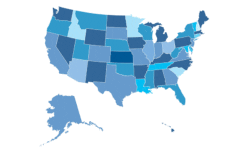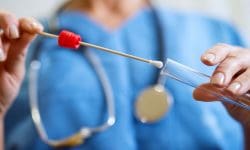Tips to Protect Employees From Exposure to Bloodborne Pathogens
Providing equipment such as gloves and goggles, offering training on contamination prevention and implementing related practices and policies at your operation will ensure the health and safety of employees.

Imagine receiving a call that a child has been injured while boarding one of your school buses. The driver stated that a young girl has fallen on the steps and her head is bleeding. The dispatcher has called 911, but you are requested at the scene.
You arrive just as firefighters and paramedics take over caring for the victim. These rescuers do their job well — the victim is stabilized, wrapped up for transport to the hospital and gently placed on the stretcher.
As you watch, you can’t help but notice that the firefighters and paramedics are wearing medical gloves and goggles. As EMS (emergency medical services) personnel leave the area, you approach your driver, who is talking with a police officer. Almost immediately you become aware of a very frightening sight — your driver has fairly large spots of blood on her clothing and, even more upsetting, she is using a hand towel to wipe the blood off of her hands. It is obvious that this driver did nothing to protect herself from disease transmission and has been contaminated with the victim’s blood.
Wearing PPE (personal protective equipment) is an important part of professional rescuers’ equipment. They know that protecting themselves from bloodborne pathogens is, in some ways, just as important as caring for the victim. But what about your people — your drivers, mechanics and even your office personnel — do they know this and know the risks associated with not wearing protective equipment?
If your company provides first aid kits for employee use or if your employees are required to respond to a medical emergency, they should have access to protective equipment and receive training on bloodborne pathogens.
Assess Your Operation’s Risk for Exposure
I was recently asked to evaluate exposure risks for an association of tow truck operators, body shop technicians and auto mechanics. These people lacked training on bloodborne pathogens.
Tow truck operators wear thick, leather work gloves and routinely pick up bloodstained windshields or wrap contaminated airbags around steering columns. Body shop technicians pull contaminated seats from wrecked vehicles and then sit on them during their breaks or at lunchtime. Mechanics have a tendency to cut their knuckles or foreheads while repairing vehicles. They also share tools with fellow employees — tools that are contaminated with blood from their last injury.
I know you’re not in the automobile repair business. The examples above are intended to get you thinking about your own operation’s risks of exposure to potentially dangerous body fluids. Do you have a first responder team or people assigned to respond to an emergency? Are first aid kits available to employees? Do employees share equipment or tools that could become contaminated? Who is responsible for cleaning up body fluids after an accident or injury?
Without proper communication policies and training in preventing disease transmission, your employees could find themselves exposed to the same dangers paramedics and firefighters face while coming to their aid.
So what can you do to reduce the risk of exposure? Let’s start with defining bloodborne pathogens and the impact that exposure to them can have on employees and employers.
Contamination Prevention Guidelines
Bloodborne pathogens are pathogenic microorganisms that are transmitted via human blood and cause disease in humans. They include — but are not limited to — hepatitis B and human immunodeficiency virus (HIV).
I know for many people (myself included) words like microorganisms, immunodeficiency and pathogens bring back thoughts of high school and health classes — the last places in the world most of us want to revisit. So before we go any further, let me put it in my terms: There’s a lot of junk out there that can make us very sick, or even kill us if we become contaminated.
We need to constantly be on guard and be very careful so that we don’t become contaminated. I’ve been teaching CPR and first aid training for more than 25 years, and I’m often asked if I would do rescue breathing without a barrier on someone I do not know. I respond without hesitation: If I found someone unresponsive and not breathing, I would immediately call for help and begin chest compressions on the victim, but there is no way I would do mouth-to-mouth on the individual without a breathing barrier.
Emergency responders know the risks associated with coming in contact with bloodborne pathogens, and they know how to protect themselves. Unfortunately, far too many people in the workplace or good Samaritans on the street do little, if anything, to take the necessary precautions. Too often they realize they’ve been exposed to body fluids after the emergency, when it’s too late to do anything about it.
Here are a few simple rules to follow when faced with the possibility of exposure to bloodborne pathogens, or any body fluids for that matter. This information is presented as guidelines for both employees and employers. The American Heart Association calls it “Making a PACT, Know How to Act.”
PROTECT — Protect yourself from blood or blood-containing materials. This includes wearing protective equipment such as gloves and goggles and using a breathing barrier if you are performing CPR. Consider your options if you find yourself with no protective equipment.
ACT — If you find you have come into contact with another person’s blood or other body fluids, act quickly and safely. Wash the area immediately with hot, soapy water for up to a minute before rinsing. If your eyes have been contaminated, flush them with clean water for up to five minutes. If a flushing agent is not available at the scene, have someone get water for you. Firefighters or paramedics can assist you if they are still at the scene.
CLEAN — After an emergency, especially in the shop area or office, clean any areas contaminated with blood or body fluids. Wear protective equipment. Clean the area with a solution of one part Clorox and eight parts water. Completely flush the area and let the solution stand for at least three minutes. Be careful when wiping up the area, especially if you are dealing with broken glass or wood or metal splinters. Put all soiled items, including soiled cleaning materials, in a plastic bag and take it to the dumpster as soon as you are finished. If there is an injection device (such as a needle) involved, try to give it to the medics or firefighters before they leave; otherwise, get it in the dumpster and use extreme caution while doing so.
If you appreciated this article and want to receive more valuable industry content like this, click here to sign up for our FREE digital newsletters!
 Leading in Turbulent Times: Effective Campus Public Safety Leadership for the 21st Century
Leading in Turbulent Times: Effective Campus Public Safety Leadership for the 21st Century
This new webcast will discuss how campus public safety leaders can effectively incorporate Clery Act, Title IX, customer service, “helicopter” parents, emergency notification, town-gown relationships, brand management, Greek Life, student recruitment, faculty, and more into their roles and develop the necessary skills to successfully lead their departments. Register today to attend this free webcast!







